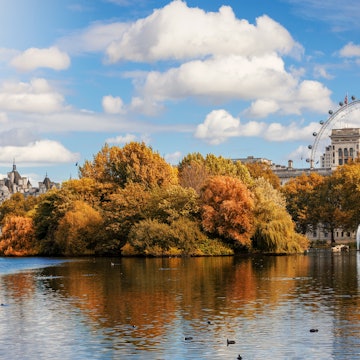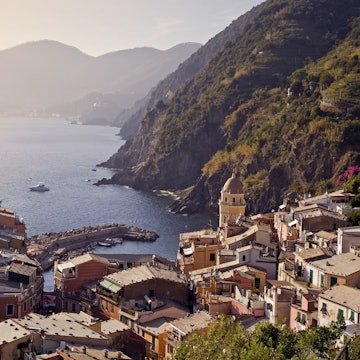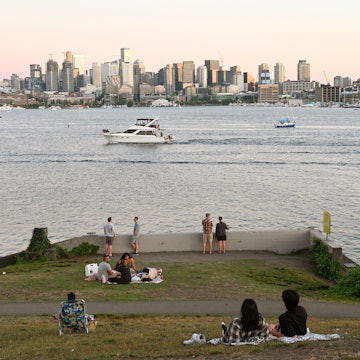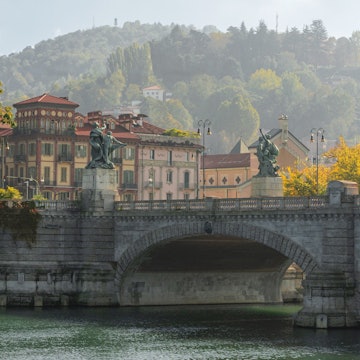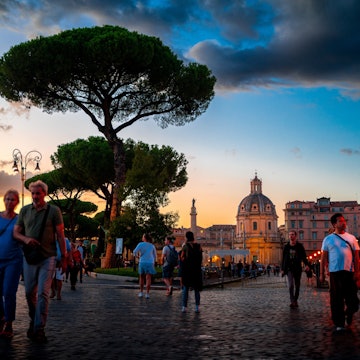

Exploring Campania at a leisurely pace is the best way to experience southern Italian life. Shutterstock
In the sultry south, Campania is Italy with the volume turned up – it’s hotter, louder, livelier, bellissima and jam-packed with all the things you came here for in the first place, from epic Roman ruins and puffing volcanoes to soulful cities filled with palazzi, cafe-rimmed piazzas, Gothic churches and galleries hiding Caravaggio art.
Coastal roads swoop dramatically along clifftops leading to insanely pretty pastel towns and villages pinned to hillsides, secluded coves and golden sands. Boats chug over the Tyrrhenian Sea as it fades from turquoise to sapphire blue to islands with glitz and glamour.
How much of this you get to experience depends on time, budget and inclination, but try not to cram in everything at once. This region is no place to rush and richly rewards those who let its magic unfold slowly. This first-time guide has everything you need to get you started.

When should I go to Campania?
If you want to do anything other than flop on the sand, cool off in a lido or hang out at a harborside bar, definitely avoid peak summer (July and August) when temperatures, prices and crowds rocket. In summer, the roads can also be chock-a-block, especially around the Amalfi Coast, beaches are packed and good-value hotels are like gold dust (booked months in advance). If you come now, expect parties, parades, festivals, fireworks and outdoor concerts around Ferragosto (15th August).
Shoulder seasons bring better deals and are ideal for exploring and hiking. Spring can be mild, bright and glorious, with temperatures hovering around 20°C (68°F). On the coast, most things open around Easter. For a true flavor of the region, catch the Settimana Santa parades across the region during Holy Week. Sorrento’s White Procession is the most atmospheric, where hooded penitents parade through the streets by flickering torchlight. September is another cracking month to visit, with the grape harvest in full swing, far fewer visitors and a flurry of local sagre (food festivals) bigging up local produce.
Winter brings quieter, cooler and wetter days. Coastal resorts slink into hibernation, but this can be a great season for scoring rock-bottom room rates and diving into Naples’ museums. Pre-Lenten carnival enlivens February with confetti, carri (floats) and flamboyant costumes.
How much time should I spend in Campania?
If you’re pushed for time, you could sneak off to Naples for a long weekend and see a fair bit of the UNESCO World Heritage centro storico (historic center), where the narrow streets are lined with palazzi, dripping washing and cafe terraces. In the space of a few days and with clever planning, it’s possible to squeeze in trophy sights like the vast, Gothic and magnificent Basilica di Santa Chiara, the 13th-century Castel Nuovo (find fragments of Giotto frescoes in its chapel), and the outstanding MANN museum, which dives deep into the region’s Greco-Roman riches. With an extra day, you can fit in a walking tour of Naples homing in on the city’s food or street art scenes.
But honestly, if you come for a few days, you'll wish you had stayed longer. With five days you can venture further afield, tagging on visits to the spine-tingling Roman ruins of Herculaneum or Pompeii, or breezing across to volcanic islands in the Bay of Naples: glamorous and gorgeous Capri, Ischia with its thermal spas and lush gardens, and quainter, quieter Procida.
Book a week to head south for cliff-wrapped drama, cinematic views and beach days with a shot of glamor on the ever-romantic Amalfi Coast. Two weeks or more? Lucky you. South of Salerno, things take a turn for the wilder on the Cilento Coast, where you can go off-piste to secluded coves lapped by the Tyrrhenian Sea, sun-bleached towns moving to a slow beat and the spectacularly preserved Greek temples of Paestum.

Is it easy to get in and around Campania?
Fly here and you’ll probably land at Naples' International Airport, southern Italy's biggest transport hub, located 7km (4.3 miles) north of the city center. The airport serves plenty of destinations across Europe and is served by budget airlines including Ryanair and easyJet. Alibus shuttle connects the airport to the main train station on Piazza Garibaldi in central Naples and the port. Tickets can be purchased in advance online and cost €5 Euro (US$5.25); the journey takes 15 minutes.
Naples is also a major port, operating year-round ferries and hydrofoils to the islands of Capri, Ischia and Procida and the Amalfi Coast (see Direct Ferries for times and tickets).
EAV trains link Napoli Centrale station with Sorrento via Herculaneum, Pompeii and other towns along the coast, but if you want to properly explore Campania, you’re going to need your own wheels. Driving in Naples can be hair-raising (prepare for beeps, gestures and sudden swerves), and you’ll also need nerve for the hairpin roads and traffic of the Amalfi Coast. Roads are slightly calmer in the Cilento region south of Salerno, giving you the freedom to discover remote towns and beaches.
Top things to do in Campania
You can never see it all in one bite, so pace yourself. The list of the best things to do in Campania is endless, but if you’re here for the first time these experiences are unmissable.
Revel in Roman Pompeii
The haunting, UNESCO World Heritage ruins of Pompeii are once seen, never forgotten. Mt Vesuvius smolders above this vast, astonishingly intact archaeological site and it was this monster volcano that obliterated a once thriving Roman town when it erupted in 79 CE, burying it under layers of molten lava, ash and pumice. Feel the pulse of the past as you explore its marketplaces, bathhouses, temples, frescoed villas and amphitheaters where gladiators did bloody battle. Arrive early and visit in the low season to beat the worst crowds.

Unplug on Procida
Bubbling up from the Bay of Naples, the dinky volcanic island of Procida is often eclipsed in favor of the neighboring isles of Capri and Ischia, but it’s here on cliff-backed coves and in pastel-hued marinas dishing up local seafood that you’ll find a refreshingly slow and authentic slice of southern Italian life. You can reach Procida by hydrofoil from Naples; the journey takes just 25 minutes.
Eat Neapolitan pizza
Rome goes thin and crispy, but Naples prefers its pizza softer and fluffier (more base, less topping). Tracking down the city’s best leads you into the beating heart of the working-class district of La Sanità, where streets lead to pizza hotspots like slow-food Concettina ai Tre Santi, run by the Oliva family for generations.
Or nip into sweet-and-simple L’ Antica Pizzeria da Michele, founded in 1870, where margherita and marinara pizzas are baked to perfection in a wood-fired oven. You might remember it as where Julia Roberts ate pizza in the 2010 film Eat, Pray, Love.

Find romance on the Sorrento Peninsula
If you think the rest of Campania is lovely, wait until you see the Sorrento Peninsula, where roads corkscrew along cliff edges to olive and lemon groves and rock-top, pastel-painted villages that look like film-set stuff. Poets like Lord Byron and Keats found romance in Sorrento, once a stop on the 19th-century Grand Tour. Go south and you’ll be blown away by the beauty of turquoise bays like Baia di Leranto, where you can swim, snorkel and kayak, and Punta Campanella, with soul-stirring views of Capri.
Hike to Mt Vesuvius
Hovering above the Bay of Naples, 1281m-high Mt Vesuvius is both a beauty and a beast. When it blew its top in 79 CE, it devastated the Roman towns of Pompeii and Herculaneum. Mainland Europe’s only active volcano, it last erupted in 1944. You can admire it from photogenic angles from afar but to get up close and personal with the sleeping giant, hook onto one of the nature trails in the national park. The pick of the lot is the trail to the summit, where you can peer into its crater and gaze out across the blue glitter of the Tyrrhenian Sea.

My favourite thing to do in Campania
If the Amalfi Coast looks lovely from behind the wheel, it is even more ravishing when you slow the pace and pop a pair of walking boots on to hike the 8km (5 miles) Sentiero degli Dei. It’s called the "Path of the Gods" for good reason – the views on this cliff-skimming trek from Agerola (Bomerano) to Nocelle are heavenly. Here, the thickly wooded Lattari Mountains crash into a sea of sapphire blue, pastel-painted villages cling to sheer rock faces and the island of Capri winks on the horizon. The joy of hiking means you get to stop for photos, picnics and dips in the sea. Tripping down 1700 steps to pretty Positano is the icing on the cake.
How much money do I need for Campania?
The ritzy island of Capri and the towns and resorts beading the Amalfi Coast (Sorrento, Ravello, Amalfi and Positano) like diamonds on a necklace, attract the rich and famous and come with a price tag to match. Room rates skyrocket during peak season, sunbeds on the beach can set you back as much as €50 (US$52.50) a piece and you’ll get little change from €100 (US$105) for even the simplest cafe lunch.
Beyond this five-star turf, Campania is relatively affordable and on par with much of Italy. If you want to economize, swap pricey hotels for campgrounds, hostels, family-run B&Bs and Airbnb rentals. Avoid peak summer and you can score good deals on flights and rooms. If you don’t have a massive budget, seek out cheap-as-chips street food, pizzerias and bakeries selling sfogliatella (cinnamon-laced ricotta pastries). Most places accept cards but it’s always handy to have change for small buys and tips.
Basic room for two in a budget hotel or B&B: €60-100 (US$63-105)
Room for two in an upscale hotel: €150-450 (US$157.50-472.50)
Self-catering apartment (including Airbnb): from €70 (US$73.50)
Train ticket from Naples to Pompeii: €4 (US$4.20)
Naples to Capri hydrofoil ticket (one way): €24 (US$25.20)
Entry to major archaeological site: €16-18 (US$16.80-18.90)
Coffee: €2-3 (US$2.10-3.15)
Simple pasta lunch: €15 (US$15.75)
Pizza in Naples: €6-8 (US$6.30-8.40)
Scoop of ice cream: €3 (US$3.15)
Dinner for two at an upscale restaurant: €80-120 (US$84-126)

What should I pack for Campania?
Bring flat, comfy shoes (for cobbled streets) and smart casual clothes for Naples. Throw in something dressy for the evening, and pack layers (a jumper or jacket) for spring and autumn. In summer, you’ll want to keep cool – pack shorts, sundresses, shades, a hat and sunscreen for the city and coast. Dress modestly in churches (shoulders and knees covered).
How can I get a slice of local life in Campania?
Instead of randomly ticking off sights, factor in a few days for serendipitous exploring. Allow time to hang out on piazzas, relax on cafe terraces, pound the backstreets, savor a gelato and embrace the evening ritual of the passeggiata (stroll) as the lights flick on. Ask locals to divulge their favorite places and avoid restaurants with tourist menus and touts.
Is Naples safe to visit?
Naples once had a reputation for being a dangerous city. Today, it’s generally safe to visit as long as you take the usual common-sense precautions, such as keeping your valuables safely stashed and bag strapped across your body and being aware of pickpockets in busy places.
How should I order coffee in Campania?
Campanians are crazy about coffee and believe theirs is Italy’s best. See for yourself by ordering un caffè, a shot of richly aromatic espresso, then standing at the bar and downing it in several sips. If you don’t want sugar, ask for it amaro (bitter). It will generally come with a glass of water. Take the lead of locals and save milky coffees like lattes and cappuccinos for the morning.







